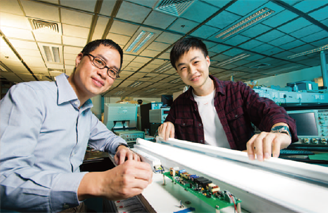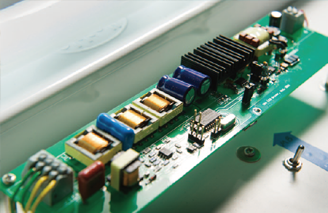Fluorescent lamps have been widely utilized in many residential, commercial and industrial sectors as they offer high efficacy and have
proven operational stability. As they require a high voltage initially to discharge the lamp and have negative resistance, a device called
ballast is used to generate the ignition voltage and regulate the lamp current. Ballasts are of two major kinds, low-frequency
electromagnetic and high-frequency electronic. Electromagnetic ballasts are made of passive components. They have the advantages of
high reliability, long lifetime, and robustness against transient voltage surge and hostile working environment. Electronic ballasts are
widely adopted as they have an overall economic benefit. Moreover, they have good performance characteristics: high input power factor,
low input current harmonics, good lamp current crest factor, high efficiency, and low flickering.

Prof Henry CHUNG and Dr Nan CHEN

LED replacement lamp driver with universal compatibility
|
|
Fluorescent lamps contain mercury in the form of vapor or solid inside the glass tube. This imposes a serious concern for landfills and waste
incinerators, causing air and water pollution. With recent advances in microelectronics technology, light-emitting-diode (LED) lighting is
becoming popular in general lighting and special purpose lighting. It has low power consumption, long life expectancy and high resistant
to vibration failure. Moreover, they can operate on a low voltage and contains no mercury. Thus, it would be advantageous if fluorescent
lamps could be substituted by LED lamps directly. The project team has developed an LED replacement lamp driving technology with
universal compatibility. The distinct feature of this technology is that it is operable by different power sources, including conventional
electromagnetic ballasts, high-performance electronic ballasts, and ac mains. The nominal operating frequency of the electromagnetic
ballast and ac mains is low, either 50Hz or 60Hz. The one of the electronic ballasts is much higher, ranging from 40kHz to 80kHz. The
proposed LED replacement lamp is able to be operated at a wide range of operating frequency and voltage levels. When the lamp is
connected to an electromagnetic ballast or ac mains, its input current has high input power factor and low total harmonic distortion. When
it is connected to an electronic ballast, it will simulate the input characteristics of a gas discharge lamp and takes sinusoidal input current.
Hence, existing fluorescent lamps can be replaced readily by the proposed LED replacement lamps, irrespective of the type of the ballast used.
This concept is truly environmentally-friendly, as the lighting network can be converted from fluorescent into LED without modifying the light
network or infrastructure. In addition, as the lamp can be operated from the ac mains, like an ordinary light bulb. The proposed technology
is applicable for new installation or retrofit market. For the new installation, the LED lamp can be powered from the ac mains without
requiring any external ballast. For the retrofit market, existing fluorescent lamps can be replaced by the LED lamps without modifying the
lighting infrastructure. Finally, the technology is generic as it can be applied to different lamp types, like the compact fluorescent lamps.
Prof Henry Shu Hung CHUNG
Department of Electronic Engineering
City University of Hong Kong
eeshc@cityu.edu.hk
|
